

Students with Disabilities. Five Key Components of Reading No more roadblocks to reading.
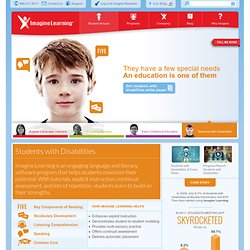
Students with disabilities often struggle to acquire basic reading skills. Research indicates that these students benefit from instruction that is explicit and sequenced, ensuring that key prerequisite skills are met before more complex tasks are required. Imagine Learning provides explicit instruction in five basic reading skills: phonological awareness, phonics, fluency, vocabulary, and comprehension. DEC_NAEYC_EC_updatedKS.pdf (application/pdf Object) Earlychildhood NEWS - Article Reading Center. In many preschools and child care programs today you can find a growing number of special-needs children.
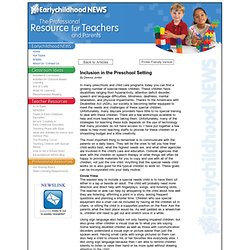
These children have disabilities ranging from hyperactivity, attention deficit disorder, speech and language difficulties, blindness, deafness, mental retardation, and physical impairments. Thanks to the Americans with Disabilities Act (ADA), our society is becoming better equipped to meet the needs and challenges of these special children. Unfortunately, many daycare providers have little to no special training to deal with these children.
There are a few workshops available to help and more teachers are taking them. Unfortunately, many of the strategies for teaching these kids depends on the use of technology that many providers do not have access to. The most important thing to remember is to communicate with the parents on a daily basis. A documentary by Dan Habib. Inclusioninclassroomtips.pdf (application/pdf Object) Untitled. Teaching Students with Disabilities. Mission of the Disabled Students' Program Responsibilities of the Disabled Students' Program Responsibilities of the Instructor Responsibilities of the Student General Suggestions on Teaching Students with Disabilities Teaching Students with Autism Spectrum Disorders Teaching Students with Chronic Illness or Pain Teaching Students Who are Deaf or Hard of Hearing Teaching Students with Learning Disabilities Teaching Students with Attention-Deficit/Hyperactivity Disorder Teaching Students with Limited Manual Dexterity Teaching Students with Mobility Impairments Teaching Students with Psychological Disabilities Teaching Students with Speech Impairments Teaching Students with Visual Disabilities How DSP Can Assist Instructors at UC Berkeley Mission of the Disabled Students' Program A note about our usage of the words "disabled" and "disability": In law, University policies, and common parlance, terms like "disabled" and "disability" have a variety of meanings, many of which are contextual.
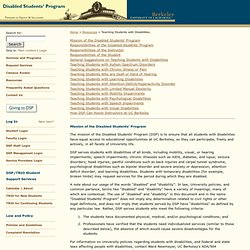
Resources For The Classroom. Centers: Effective Structures for Differentiation. Photo by Woodley Wonder Works This article is written by Katie Haydon, founder of Ignite Creative Learning Studio.
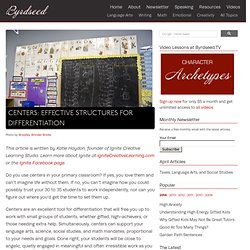
Learn more about Ignite at IgniteCreativeLearning.com or the Ignite Facebook page. Do you use centers in your primary classroom? If yes, you love them and can’t imagine life without them. If no, you can’t imagine how you could possibly trust your 30 to 35 students to work independently, nor can you figure out where you’d get the time to set them up. Centers are an excellent tool for differentiation that will free you up to work with small groups of students, whether gifted, high-achievers, or those needing extra help. Centers, in my opinion, go beyond mundane and standard worksheet tasks. Though centers can be used at any time in the year, some teachers like to wait at least a week or two, and sometimes six weeks into the school year to implement them so that they can gain a greater understanding of their students and be confident that they are ready to follow protocol.
Mystery Cube. The Mystery Cube interactive has been changed to a new format: the Cube Creator.
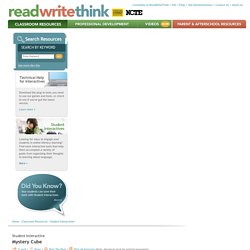
Summarizing information is an important postreading and prewriting activity that helps students synthesize what they have learned. The interactive Cube Creator offers four options: Bio Cube: This option allows students to develop an outline of a person whose biography or autobiography they have just read; it can also be used before students write their own autobiography. Specific prompts ask students to describe a person's significance, background, and personality. Mystery Cube: Use this option to help your students sort out the clues in their favorite mysteries or develop outlines for their own stories. CAST UDL Lesson Builder. Inclusive Education. The Promise of Inclusive Education.
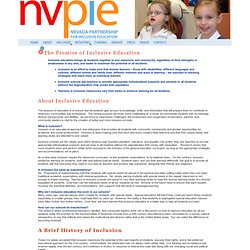
The Benefits of an Inclusion Classroom. Inclusion. Inclusion is part of a much larger picture then just placement in the regular class within school.
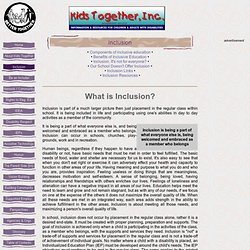
It is being included in life and participating using one's abilities in day to day activities as a member of the community. It is being a part of what everyone else is, and being welcomed and embraced as a member who belongs. Inclusion can occur in schools, churches, play- grounds, work and in recreation. Human beings, regardless if they happen to have a disability or not, have basic needs that must be met in order to feel fulfilled. The basic needs of food, water and shelter are necessary for us to exist. In school, inclusion does not occur by placement in the regular class alone, rather it is a desired end-state. Inclusion in school requires a shift in the paradigm, instead of getting the child ready for the regular class, the regular class gets ready for the child.
Written by Colleen F. Material Copyrighted 1996 Kids Together, Inc. Don't Miss the section on "Inclusive IEP planning! " Classroom Strategies For Inclusion Of Students With Communication And Learning Disorders. ContentIntroductionAbout Communications and Learning DisordersParental Suggestions to Give to TeachersIntroduction Teachers in typical classrooms who are faced with students in their classroom who have ADHD (Attention Deficit/Hyperactivity Disorder), SLD (Specific Learning Disability) and/or High Functioning Autistic Spectrum often experience the following feelings. * at a loss for what to do * wanting to pull hair out * overwhelmed * befuddled, confused and dismayed.

Strategies: Communicate Respect, Fairness, and High Expectations. The Inspirational Teacher Series – Nicole Eredics. We have started a weekly feature on Special Education Advisor called the “Inspirational Teacher Series“.
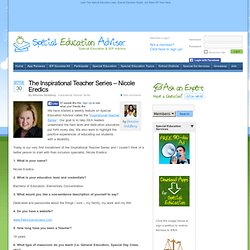
Our goal is to help SEA readers understand the hard work and dedication educators put forth every day. We also want to highlight the positive experiences of educating our students with a disability. Today is our very first installment of the Inspirational Teacher Series and I couldn’t think of a better person to start with than inclusion specialist, Nicole Eredics. 1.
What is your name? Nicole Eredics 2. Bachelor of Education, Elementary Concentration 3. Dedicated and passionate about the things I love – my family, my work and my life! 4. Www.theinclusiveclass.com 5. 18 years 6. Inclusive classrooms from grades K-7 7. Universal Design for Learning, RTI, Assistive Technology, ABA and a variety of other accommodations/modifications as outlined in IEPs. Legal Requirements.